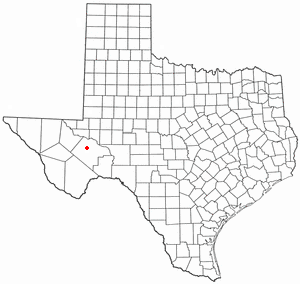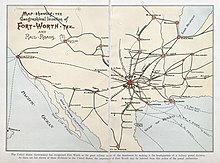Tandy Corporation was an American family-owned leather goods company based in Fort Worth, Texas, United States. Tandy Leather was founded in 1919 as a leather supply store. By the end of the 1950s, under the tutelage of then-CEO Charles Tandy, the company expanded into the hobby market, making leather moccasins and coin purses, making huge sales among Scouts, leading to a fast growth in sales.

Fort Worth is the fifth-largest city in the U.S. state of Texas and the 13th-largest city in the United States. It is the county seat of Tarrant County, covering nearly 350 square miles (910 km2) into four other counties: Denton, Johnson, Parker, and Wise. According to a 2022 United States census estimate, Fort Worth's population was 958,692. Fort Worth is the second-largest city in the Dallas–Fort Worth–Arlington metropolitan area, which is the fourth most populous metropolitan area in the United States.

Fort Stockton is a city in and the county seat of Pecos County, Texas, United States. It is located on Interstate 10, future Interstate 14, U.S. Highways 67, 285, and 385, and the Santa Fe Railroad, 329 mi (529 km) northwest of San Antonio and 240 mi (390 km) southeast of El Paso. Its population was 8,283 at the 2010 census.

The American frontier, also known as the Old West or the Wild West, encompasses the geography, history, folklore, and culture associated with the forward wave of American expansion in mainland North America that began with European colonial settlements in the early 17th century and ended with the admission of the last few western territories as states in 1912. This era of massive migration and settlement was particularly encouraged by President Thomas Jefferson following the Louisiana Purchase, giving rise to the expansionist attitude known as "Manifest Destiny" and the historians' "Frontier Thesis". The legends, historical events and folklore of the American frontier have embedded themselves into United States culture so much so that the Old West, and the Western genre of media specifically, has become one of the defining periods of American national identity.

RadioShack, formerly RadioShack Corporation, is an American retailer founded in 1921.

Charles Francis Colcord was a cattle rancher, U.S. Marshal, Chief of Police, businessman, and pioneer of the Old West. The community of Colcord, Oklahoma is named for him.
This is a broad outline history of the state of Montana in the United States.

Fort Griffin, now a Texas state historic site as Fort Griffin State Historic Site, was a US Cavalry fort established 31 July 1867 by four companies of the Sixth Cavalry, U.S. Army under the command of Lt. Col. S. D. Sturgis, in the western part of North Texas, specifically northwestern Shackelford County, to give settlers protection from early Comanche and Kiowa raids. Originally called Camp Wilson after Henry Hamilton Wilson, a recently deceased lieutenant and son of Radical Republican senator and later vice president, Henry Wilson, it was later named for Charles Griffin, a former Civil War Union general who had commanded, as de facto military governor, the Department of Texas during the early years of Reconstruction.

The Fort McKavett State Historic Site is a former United States Army installation located in Menard County, Texas. The fort was first established in 1852 as part of a line of forts in Texas intended to protect migrants traveling to California. The fort was deemed unnecessary and abandoned in 1859 and was occupied by settlers. From 1861 to 1863, during the American Civil War, the fort became an outpost of Confederate forces on the Texas frontier until they left for other theaters of the war. When the US Army returned to Texas in the later 1860s, the fort was reoccupied and rebuilt, and became a base for the "Buffalo Soldier", or all-African American, 24th Infantry and 9th Cavalry Regiments.

Downtown Fort Worth is the central business district of Fort Worth, Texas, United States. Most of Fort Worth's tallest buildings and skyscrapers are located downtown.

Fort Martin Scott is a restored United States Army outpost near Fredericksburg in the Texas Hill Country, United States, that was active from December 5, 1848, until April, 1853. It was part of a line of frontier forts established to protect travelers and settlers within Texas.

Fort Graham was a pioneer fort established in 1849 by Brevet Major R.A. Arnold at the site of Jose Maria Village, an Anadaca camp on the western edge of present-day Hill County, Texas. It remained in service until 1853, when settlements had moved further west. It was named after Col. William M. Graham, who died at the Battle of Molina del Rey.
Charles David Tandy was the chairman of the board, president, and chief executive officer of the Tandy Corporation.

Fort Gates, was a United States Army fort established on October 26, 1849, as Camp Gates by Captain William Reading Montgomery and two companies of the Eighth United States Infantry. The fort was located on the north bank of the Leon River about five miles east of the site of present Gatesville, Texas. The installation was named for Brevet Major Collinson Reed Gates of New York, a noted officer in the Battle of Palo Alto and the Battle of Resaca de la Palma. The fort was established to protect settlers on the Texas frontier from Indians. The fort was garrisoned by companies D, I, F, and H of the Eighth United States Infantry. In April 1851, 256 enlisted men and forty-five officers were stationed at Fort Gates, the most reported in a single month.
Ripley A. Arnold (1817–1853) was a major in the United States Army and founder of Camp Worth in 1849, later renamed Fort Worth, Texas. In 2014 a 22-foot statue was dedicated to Arnold. It was erected along the Trinity River below the army camp site he established and named after one of his military commanders.
Anne Valliant Burnett Tandy was an American heiress, rancher, horse breeder, philanthropist and art collector from Fort Worth, Texas.

Samuel Burk Burnett was an American cattleman and rancher from Texas, owner of the 6666 Ranch, and namesake of Burkburnett, Texas.
Anne Windfohr Marion was an American heiress, rancher, horse breeder, business executive, philanthropist, and art collector from Fort Worth, Texas. She served as the president of Burnett Ranches and the chairman of the Burnett Oil Company. She was the founder of the Georgia O'Keeffe Museum in Santa Fe, New Mexico. In 1981, she was inducted into the Hall of Great Westerners of the National Cowboy & Western Heritage Museum.
The following is a timeline of the history of the city of Fort Worth, Texas, United States.

Pioneers Rest is the oldest public cemetery in Fort Worth, Texas and one of the oldest in Tarrant County. Its use as a burial ground began in 1849, the same year that the fort was established by the United States Army.
















